1. Introduction: Natural Selection in Gene Pools
In the first tutorial in this unit, we saw how Darwin (and Wallace) proposed a theory of natural selection that explains how adaptation could arise through natural processes. As Darwin wrote in the Origin of Species
It may metaphorically be said that natural selection is daily and hourly scrutinizing, throughout the world, the slightest variations; rejecting those that are bad, preserving and adding up all that are good; silently and insensibly working, whenever and wherever opportunity offers, at the improvement of each organic being in relation to its organic and inorganic conditions of life.
Darwin was able to develop his theory despite being unaware about how genes are transmitted from one generation to the next. Now, we’ll use what we’ve learned about alleles in populations to look again at natural selection, this time from a population genetics perspective.
2. Natural Selection Directly Acts on Phenotypes

Natural selection acts on phenotypes. A phenotype is an observable trait in an organism. A phenotype could be an organism’s color, size, speed, form, or behavior. The length of an elk’s antlers, a wolf’s sense of smell, the height of a redwood tree, or the shape of an enzyme are all phenotypes
Genotypes are the underlying genes or alleles. If you inherited two alleles for cystic fibrosis (an inherited lung disease), your phenotype would involve all of the symptoms connected with cystic fibrosis (build-up of mucus in the lungs, salty sweat, problems with digestion, etc.) Your genotype would be homozygous recessive, and could be represented as “cc.” If you inherited one allele, your phenotype would be “normal,” and your genotype would be heterozygous normal, represented by “Cc.”
[qwiz style=”width: 520px; min-height: 0px; border: 3px solid black;” qrecord_id=”sciencemusicvideosMeister1961-Pop-gen: genotype v. phenotype”]
[h]Genotype v. Phenotype
[q labels = “top”]
| Genotype or Phenotype? | |
| DNA sequence | _______________ |
| Protein | _______________ |
| Shape of an enzyme | _______________ |
| Genes that code for an enzyme | _______________ |
| Height | _______________ |
| DNA that codes for a growth hormone | _______________ |
| Shape of a bird’s beak | _______________ |
| What natural selection selects | _______________ |
| Cc | _______________ |
[l]genotype
[fx] No, that’s not correct. Please try again.
[f*] Excellent!
[l]phenotype
[fx] No. Please try again.
[f*] Excellent!
[/qwiz]
3. Natural Selection Increases the Frequency of Beneficial Alleles and Decreases the Frequency of Harmful Alleles
Natural selection is frequently summarized as “survival of the fittest.” In a population genetics context, you can think of natural selection in terms of phenotypes and genotypes. Individuals who have phenotypes with some type of advantage will be selected for survival by the environment. The individuals that survive will get to pass their alleles on to the next generation. Over time, the gene pool of that population will have more copies of alleles that code for beneficial phenotypes, and less copies of alleles for harmful traits. The key idea is that through selection of phenotypes, the allele frequencies in a gene pool change. Individuals don’t evolve; populations do.
4. Natural Selection in Action: Peppered Moths, Ice Fish, and Pocket Mice
Let’s return to the peppered moth, which we discussed in an earlier tutorial in this series. Birds eat moths. Birds more frequently eat moths that are easier to see. The best-camouflaged moths get eaten less. In terms of natural selection, the birds select the best-camouflaged moths.
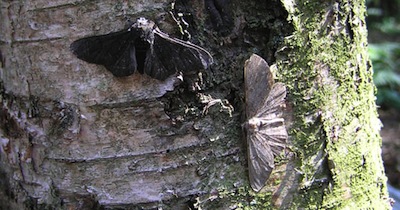
What are they selecting them for? For survival and reproduction. In other words, in the same way that during the process of artificial selection, breeders select the most desired trait, the birds are selecting the best-adapted trait. In response, over time, allele frequencies will shift to match this selective regime.
The biologist Sean Carroll has discussed this in relation to a type of ice fish that lives close to Antarctica. This fish has blood that’s almost completely clear—not red like your blood, or the blood of other fish. The reason why the blood is clear is because it lacks red blood cells, which carry the iron-rich, oxygen-absorbing protein called hemoglobin. The reason why these fish lack red blood cells is to keep their blood (and body tissues) from freezing solid in the frigid water around Antarctica. Fewer blood cells means lower blood viscosity (thickness), keeping blood moving even in freezing temperatures.
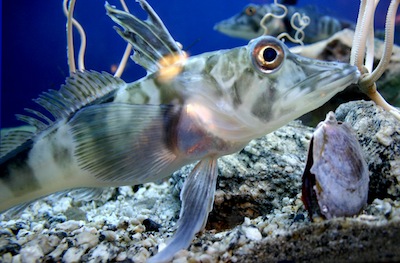
How could this have evolved? Over the past tens of millions of years, Antarctica has drifted southward to its current position, becoming colder and colder. As it did, the ancestors of these ice fish that produced fewer red blood cells (a phenotype), survived better, because they experienced tissue damage from freezing less often. At the same time, because cold fluids can hold more oxygen, the lack of red blood cells was not a survival disadvantage. Looking into these fish’s DNA, you can see how this happened. The alleles for hemoglobin accumulated mutations that prevented hemoglobin from being produced, These mutated alleles became fixed in the ice fish population. What would have been a deadly mutation in another species became a life-sustaining allele in the ice fish (See Sean Carroll, The Making of the Fittest, or read an excellent summary of his work here).
Here’s a final example. In southern Arizona, the rock pocket mouse lives on two types of landscapes: dark-colored lava, and lighter-colored sand.
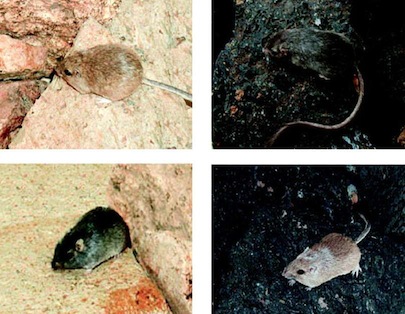
The mice on the dark-colored lava are darker colored, while those that live on sand are lighter colored. The phenotype is selected by the environment (in this case, owls who prey on the mice). And as a result, the frequencies of coat-color alleles have shifted in each population. Alleles for dark coloration are in higher frequency in the mice living on dark lava; alleles for lighter coloration are in higher frequency in the mice living on lighter sand (source: The Genetic Basis of Adaptive Melanism in Pocket Mice).
Natural Selection Can Unfold in Three Ways
The type of natural selection described above moves the average phenotype in a population in one consistent direction. In the case of the peppered moth, the darkening of tree trunks set the stage for birds who ate moths to select moths with darker coloration. Over time, as pollution continued to darken the forests, the number of moths with the dark phenotype increased, and the number of moths with a lighter phenotype decreased. This, in turn, changed the underlying allele frequencies. In the case of the ice fish, you can imagine that over the millions of years during which this adaptation took place, the number of red blood cells/unit volume of blood steadily decreased, as did the amount of hemoglobin.
This type of natural selection is called directional selection. If you were to graph the frequency of some trait (size, color, enzyme activity, etc.), it would look like what’s shown below. The average moves in a specific direction. For example, as the giraffe was evolving, the average length of the neck and legs was increasing. Or, in the case of the peppered moth, the average amount of pigment increased. For blue whales, it’s increasing size. For jackrabbits, it’s heat tolerance. For rattlesnakes, it’s venom toxicity. For cheetahs, it’s running speed.
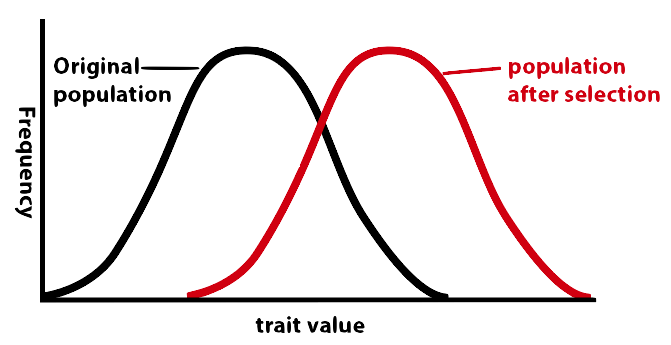
Selection doesn’t have to push in one direction. There can also be selection for the average, and away from the extremes. This is called stabilizing selection, and, if graphed, it looks like this:
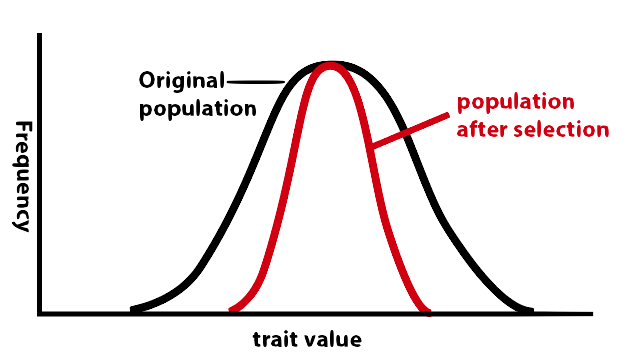
Think about the birth weight of babies. Babies that are too small have various problems that lowers their survival rate. But babies that are too large (think back to the times before Cesarian births could be safely and successfully performed) can be difficult for their mothers to deliver, also lowering the survival rate. So, if the trait is birthweight, then nature is selecting against both birthweights that are too low and those that are too high. The result is stabilization around a mean (which in babies of European descent is about 3.5 kilograms (7.7 lbs), with all but 5% of babies born between 2.5 and 5 kilograms).Wikipedia
Finally, there can be selection against the mean, and for the extremes. This type of selection is said to play an important role in dividing up gene pools as a prelude to speciation. When graphed, disruptive selection looks like this:
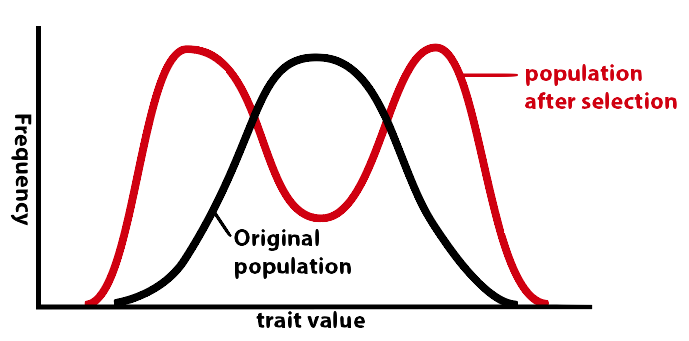
Got it? The key ideas from this section are
- The presence of harmful or beneficial changes is a violation of one of the key Hardy-Weinberg principles and results in changes in allele frequencies.
- During natural selection, the environment selects for or against certain phenotypes.
- If a phenotype is selected for, then the individuals with that phenotype will survive and reproduce at higher rates. The alleles that code for that phenotype will increase in frequency in that gene pool.
- If a phenotype is selected against, the individuals with the phenotype will survive at lower rates. The alleles that code for that phenotype will decrease in frequency in that gene pool.
- Selection comes in three main varieties
- Directional selection selects for one extreme, and against the other. This moves the average phenotype within a population in one direction.
- Stabilizing selection selects against both extremes, and for the mean. This narrows the range of variation within a population.
- Disruptive selection selects against the mean, and for the extremes. This produces a bimodal distribution of phenotypes (like the hump of an Asian camel).
If you feel that you understand these concepts well, take this brief quiz. If not, carefully re-read the material above, and then take the quiz.
[qwiz style=”width: 520px; border: 3px solid black;” qrecord_id=”sciencemusicvideosMeister1961-Pop-gen: Natural Selection in Gene Pools”]
[h]Natural Selection in Gene Pools
[q topic= “natural_selection_in_gene_pools”]When you’re looking at an organism, you’re directly looking at its
[c]IGdlbm90eXBl[Qq]
[c]IHBoZW5v dHlwZQ==[Qq]
[f]IE5vLiBUaGUgZ2Vub3R5cGUgaXMgdGhlIHVuZGVybHlpbmcgZ2VuZXMuIFdoYXQgeW91IHNlZSB3aGVuIHlvdSBsb29rIGF0IGFuIG9yZ2FuaXNtIGlzIHRoZSBleHByZXNzaW9uIG9mIHRob3NlIGdlbmVzLg==[Qq]
[f]IENvcnJlY3QuIFdoZW4geW91IGxvb2sgYXQgYW4gb3JnYW5pc20sIHlvdeKAmXJlIGxvb2tpbmcgYXQgaXRzIHBoZW5vdHlwZS4=[Qq]
[q topic= “natural_selection_in_gene_pools”]Natural selection acts on an organism’s
[c]IGdlbm90eXBl[Qq]
[c]IHBoZW5v dHlwZQ==[Qq]
[f]IE5vLiBUaGUgZ2Vub3R5cGUgaXMgdGhlIHVuZGVybHlpbmcgZ2VuZXMuIE5hdHVyYWwgc2VsZWN0aW9uICh0aGUgZW52aXJvbm1lbnQpIGNhbuKAmXQgc2VlIHRoZSB1bmRlcmx5aW5nIGdlbmVzLiBJdCBjYW4gb25seSBzZWUgdGhlIGV4cHJlc3Npb24gb2YgdGhvc2UgZ2VuZXMu[Qq]
[f]IEV4YWN0bHkuIE5hdHVyYWwgc2VsZWN0aW9uICh0aGUgZW52aXJvbm1lbnQpIGNhbiBvbmx5IGFjdCB1cG9uIGFuIG9yZ2FuaXNt4oCZcyA=cGhlbm90eXBlLg==
Cg==[Qq]
[q topic= “natural_selection_in_gene_pools”]What evolves? Populations or individuals?
[c]IHBvcHVs YXRpb25z[Qq]
[c]IGluZGl2aWR1YWxz[Qq]
[f]IFllcy4gT25lIHdheSB0byBsb29rIGF0IGV2b2x1dGlvbiBpcyBhcyBhIHNoaWZ0IGluIHRoZSBhbGxlbGUgZnJlcXVlbmNpZXMgaW4gYSBwb3B1bGF0aW9u4oCZcyBnZW5lIHBvb2wuIEluZGl2aWR1YWxzIGdldCBzZWxlY3RlZCB0byBzdXJ2aXZlIGFuZCByZXByb2R1Y2UuIFBvcHVsYXRpb25zIGV2b2x2ZS4=[Qq]
[f]IE5vLiBPbmUgd2F5IHRvIGxvb2sgYXQgZXZvbHV0aW9uIGlzIGFzIGEgc2hpZnQgaW4gdGhlIGFsbGVsZSBmcmVxdWVuY2llcyBpbiBwb3B1bGF0aW9u4oCZcyBnZW5lIHBvb2wuIEluZGl2aWR1YWxzIGdldCBzZWxlY3RlZCB0byBzdXJ2aXZlIGFuZCByZXByb2R1Y2UuIFdoYXQgZXZvbHZlcz8=[Qq]
[q topic= “natural_selection_in_gene_pools”]In the rock pocket mouse, allele “b” codes for light coloration. Allele “B” codes for darker coloration. This is shown in the table below. In a desert environment with light-colored sand, what would be selected?
[c]IHRoZSBCQiBvciBCYiBnZW5vdHlwZXM=[Qq]
[c]IGRhcmsgZnVy[Qq]
[c]IHRoZSBiYiBnZW5vdHlwZQ==[Qq]
[c]IGxpZ2h0 IGZ1cg==[Qq]
[f]IE5vLiBUaGUgZW52aXJvbm1lbnQgZG9lc27igJl0IHNlbGVjdCBnZW5vdHlwZXMuIE5leHQgdGltZSwgY2hvb3NlIGEgcGhlbm90eXBlLg==[Qq]
[f]IE5vLiBJbiBhIGxpZ2h0LWNvbG9yZWQgZW52aXJvbm1lbnQsIGEgbW91c2Ugd2l0aCBkYXJrIGZ1ciB3b3VsZCBiZSBlYXNpbHkgc2VlbiBieSBwcmVkYXRvcnMuIFRoaW5rIG9mIHNlbGVjdGlvbiBhcyB0aGUgcm9sZSBvZiB0aGUgYnJlZWRlciwgd2hvIHNlbGVjdHMgd2hpY2ggaW5kaXZpZHVhbHMgZ2V0IHRvIHN1cnZpdmUgYW5kIHJlcHJvZHVjZS4gV2hhdCBhcmUgdGhlIG93bHMgc2VsZWN0aW5nIGZvciByZXByb2R1Y3Rpb24/[Qq]
[f]IE5vLCBidXQgeW91IHNlZW0gdG8gYmUgdGhpbmtpbmcgYWJvdXQgdGhpcyBpbiBhIHNtYXJ0IHdheS4gSnVzdCByZW1lbWJlciB0aGF0IGl04oCZcyB0aGUgcGhlbm90eXBlLCBub3QgdGhlIGdlbm90eXBlLCB0aGF0IGdldHMgc2VsZWN0ZWQu[Qq]
[f]IEV4YWN0bHkuIE1pY2Ugd2l0aCBsaWdodCBmdXIgd2lsbCBiZSBiZXR0ZXIgY2Ftb3VmbGFnZWQuIEFzIGEgcmVzdWx0LCB0aGF0IHRyYWl0IHdpbGwgYmUgc2VsZWN0ZWQgZm9yIHN1cnZpdmFsIGFuZCByZXByb2R1Y3Rpb24gYnkgdGhlIGVudmlyb25tZW50Lg==[Qq]
[q topic= “natural_selection_in_gene_pools”]In the rock pocket mouse, allele “b” codes for light coloration. Allele “B” codes for darker coloration, as is shown in the table below. If a population of mice is living on dark, volcanic rock, which of the following would most likely be correct.
[c]IE93bHMgd2lsbCBkaXJlY3RseSBzZWxlY3QgYWdhaW5zdCBkYXJrIGZ1ci4=[Qq]
[c]IE93bHMgd2lsbCBkaXJlY3RseSBzZWxlY3QgYWdhaW5zdCB0aGUg4oCcQuKAnSBhbGxlbGUu4oCd[Qq]
[c]IE93bHMgd2lsbCBkaXJlY3RseSBzZWxlY3QgYWdhaW5zdCB0aGUg4oCcYmLigJ0gZ2Vub3R5cGUu[Qq]
[c]IE93bHMgd2lsbCBkaXJlY3RseSBzZW xlY3QgYWdhaW5zdCBsaWdodCBmdXIu[Qq]
[f]IE5vLiBJbiBhIGRhcmstY29sb3JlZCBlbnZpcm9ubWVudCwgdGhlIG93bHMgd2lsbCBiZSBjYXRjaGluZyBhbmQgZWF0aW5nIG1vcmUgb2YgdGhlIG1pY2Ugd2l0aCBsaWdodCBmdXIuIEluIG90aGVyIHdvcmRzLCBwcmVkYXRpb24gYnkgb3dscyByZXN1bHRzIGluIHNlbGVjdGlvbiBGT1IgdGhlIGRhcmstZnVycmVkIHBoZW5vdHlwZS4gVGhpcyBpcyBiZWNhdXNlIHRoZSBkYXJrLWZ1cnJlZCBtaWNlIHdpbGwgYmUgZWF0ZW4gbGVzcywgYW5kIHdpbGwgc3Vydml2ZSBtb3JlLCBlbmFibGluZyB0aGVtIHRvIHJlcHJvZHVjZS4=[Qq]
[f]IE5vLiBBIHByZWRhdG9yIGlzIG9ubHkgZ29pbmcgdG8gc2VlIHRoZSBwaGVub3R5cGUsIG5vdCB0aGUgZ2Vub3R5cGUuIFRoZSBvd2xzIGNhbuKAmXQgc2VlIHRoZSDigJhC4oCZIGFsbGVsZS4gV2hhdCBwaGVub3R5cGUgY2FuIHRoZXkgc2VlPw==[Qq]
[f]IE5vLiBBIHByZWRhdG9yIGlzIG9ubHkgZ29pbmcgdG8gc2VlIHRoZSBwaGVub3R5cGUsIG5vdCB0aGUgZ2Vub3R5cGUuIFRoZSBvd2xzIGNhbuKAmXQgc2VlIGEgZ2Vub3R5cGUuIFdoYXQgcGhlbm90eXBlIGNhbiB0aGV5IHNlZT8gVGhhdOKAmXMgdGhlIHBoZW5vdHlwZSB0aGV54oCZbGwgYmUgc2VsZWN0aW5nIGFnYWluc3Qu[Qq]
[f]IENvcnJlY3QuIEluIGEgZGFyay1jb2xvcmVkIGVudmlyb25tZW50LCBvd2xzIHdpbGwgc2VlIGFuZCBlYXQgbWljZSB3aXRoIGxpZ2h0IGZ1ci4gSW4gb3RoZXIgd29yZHMsIHRoZSBvd2xzIGFyZSBzZWxlY3RpbmcgYWdhaW5zdCB0aGUgbGlnaHQtZnVycmVkIHBoZW5vdHlwZS4=[Qq]
[q topic= “natural_selection_in_gene_pools”]Natural selection changes
[c]IFBoZW5vdHlwZXMgaW4gaW5kaXZpZHVhbHM=[Qq]
[c]IEdlbm90eXBlcyBpbiBpbmRpdmlkdWFscw==[Qq]
[c]IEFsbGVsZSBmcmVxdWVuY2ll cyBpbiBwb3B1bGF0aW9ucw==[Qq]
[f]IE5vLiBOYXR1cmUgY2FuIHNlbGVjdCBhIHBoZW5vdHlwZSBmb3Igc3Vydml2YWwgYW5kIHJlcHJvZHVjdGlvbi4gQnV0IHRoZSBzZWxlY3Rpb24gcHJvY2VzcyBkb2VzbuKAmXQgY2hhbmdlIHRoYXQgcGhlbm90eXBlLiBPdmVyIHRpbWUsIHdoYXQgY2hhbmdlcz8=[Qq]
[f]IE5vLiBUaGUgZW52aXJvbm1lbnQgZG9lc27igJl0IGNoYW5nZSBhbiBvcmdhbmlzbeKAmXMgZ2Vub3R5cGUuIEV2b2x1dGlvbmFyeSBjaGFuZ2UgZG9lc27igJl0IGhhcHBlbiBvbiBhbiBpbmRpdmlkdWFsIGxldmVsLiBXaGF04oCZcyB0aGUgbGV2ZWwgb2YgYmlvbG9naWNhbCBvcmdhbml6YXRpb24gdGhhdOKAmXMgbGFyZ2VyIHRoYW4gdGhlIGluZGl2aWR1YWwgKGFuZCB0aGUgbGV2ZWwgb24gd2hpY2ggZXZvbHV0aW9uYXJ5IGNoYW5nZSBvY2N1cnM/KQ==[Qq]
[f]IENvcnJlY3QuIEJ5IHNlbGVjdGluZyBwaGVub3R5cGVzLCBuYXR1cmFsIHNlbGVjdGlvbiBjaGFuZ2VzIHRoZSBhbGxlbGUgZnJlcXVlbmNpZXMgb2YgYSBwb3B1bGF0aW9uLg==[Qq]
[q topic= “natural_selection_in_gene_pools”]In a gene pool, a dominant allele has a frequency of 0.2 (20%) and the recessive allele has a frequency of 0.8 (80%). If neither allele is for a phenotype that is being acted upon by the environment, then after 10 generations, you would expect that
[c]IHRoZSBhbGxlbGUgZnJlcXVlbmNpZXMgd2 lsbCByZW1haW4gYWJvdXQgdGhlIHNhbWUu[Qq]
[c]IFRoZSByZWNlc3NpdmUgYWxsZWxlLCBiZWNhdXNlIGl04oCZcyBhbHJlYWR5IHNvIG11Y2ggbW9yZSBjb21tb24sIHdpbGwgYmVjb21lIGZpeGVkIGF0IDEuMCBvciAxMDAl[Qq]
[c]IFRoZSBkb21pbmFudCBhbGxlbGUsIGJlY2F1c2UgaXQgZG9taW5hdGVzIHRoZSByZWNlc3NpdmUgYWxsZWxlLCB3aWxsIHN0ZWFkaWx5IGluY3JlYXNlIGluIGZyZXF1ZW5jeS4=[Qq]
[f]IFllcy4gVW5sZXNzIHNvbWUgZm9yY2UgbGlrZSBuYXR1cmFsIHNlbGVjdGlvbiBpcyBhY3RpbmcgdXBvbiBhIHBvcHVsYXRpb24sIHRoZSBmcmVxdWVuY3kgb2YgdGhlIGFsbGVsZXMgdGhhdCBtYWtlIHVwIGl0cyBnZW5lIHBvb2wgc2hvdWxkIHJlbWFpbiBhYm91dCB0aGUgc2FtZS4=[Qq]
[f]IE5vLiBUaGVyZeKAmXMgbm8gYnVpbHQtaW4gdGVuZGVuY3kgZm9yIGZyZXF1ZW50IGFsbGVsZXMgdG8gYmVjb21lIG1vcmUgZnJlcXVlbnQuIFVubGVzcyBzb21lIGZvcmNlIGxpa2UgbmF0dXJhbCBzZWxlY3Rpb24gaXMgYWN0aW5nIHVwb24gYSBwb3B1bGF0aW9uLCB0aGUgZnJlcXVlbmN5IG9mIHRoZSBhbGxlbGVzIHRoYXQgbWFrZSB1cCBpdHMgZ2VuZSBwb29sIHNob3VsZCByZW1haW4gYWJvdXQgdGhlIHNhbWUu[Qq]
[f]IE5vLiBVbmxlc3Mgc29tZSBmb3JjZSBsaWtlIG5hdHVyYWwgc2VsZWN0aW9uIGlzIGFjdGluZyB1cG9uIGEgcG9wdWxhdGlvbiwgdGhlIGZyZXF1ZW5jeSBvZiB0aGUgYWxsZWxlcyB0aGF0IG1ha2UgdXAgaXRzIGdlbmUgcG9vbCBzaG91bGQgcmVtYWluIGFib3V0IHRoZSBzYW1lLiBEb21pbmFudCBhbGxlbGVzIGFyZSBvbmx5IGRvbWluYW50IGluc29mYXIgYXMgdGhleSBjYW4gbWFzayBhIHJlY2Vzc2l2ZSBhbGxlbGUgd2hlbiBib3RoIGFwcGVhciBpbiB0aGUgc2FtZSBpbmRpdmlkdWFsLiBPbiBhIHBvcHVsYXRpb24gbGV2ZWwsIHRoZXJl4oCZcyBub3RoaW5nIGFib3V0IGRvbWluYW50IGFsbGVsZXMgdGhhdCB3aWxsIG1ha2UgdGhlbSBpbmNyZWFzZSBpbiBmcmVxdWVuY3ku[Qq]
[/qwiz]
Links
- Why Harmful Recessive Alleles Don’t Disappear (the next tutorial in this series)

